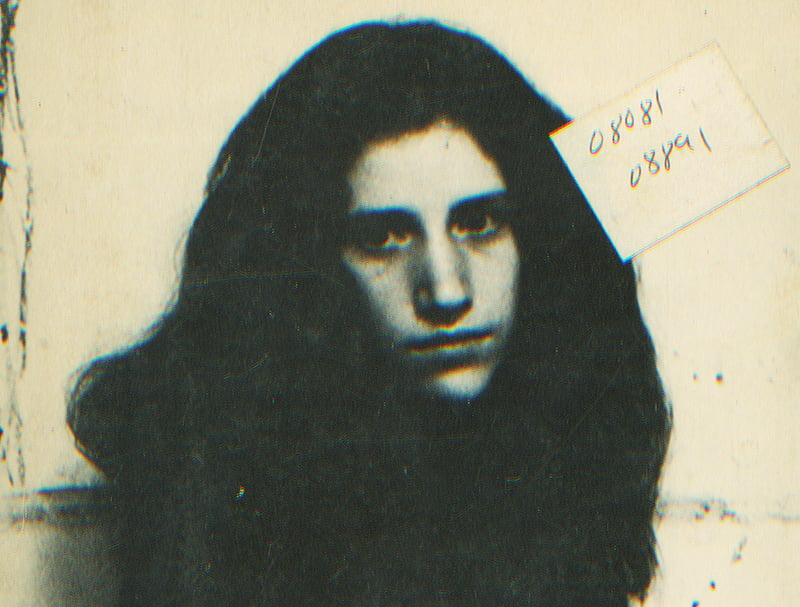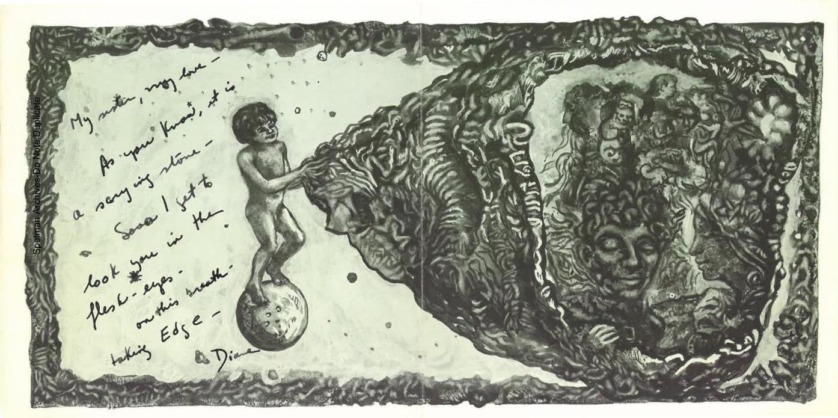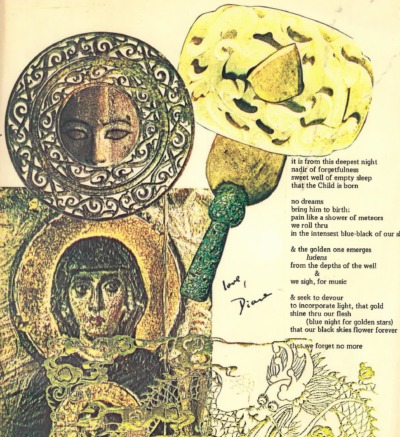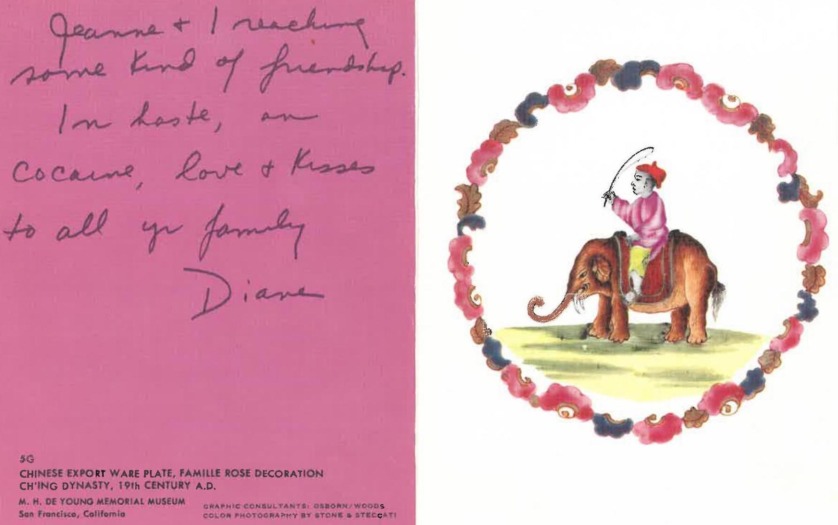A Living Weapon in Your Hand

In the archives of Spelman College are two folders of letters from Diane di Prima to her lifelong friend Audre Lorde, whom she had met as a teenager at New York’s Hunter College in the 1950s. Most are short postcards, dashed off spontaneously (“In haste, on cocaine, love and kisses to all yr family,” ends one) to record impressions of travels, to report on the progress of children’s teeth and the state of the rose garden in Golden Gate Park, to thank Lorde for sending on her daughter’s outgrown clothes, reciprocated with gifts of squash blossoms. Many contain sentences that might form the opening lines to unwritten poems: “Dreamed of you last night, in this Holiday Inn in the middle of the California desert”; “We all thrive, in cosmic glee and endless poverty”; “Nothing really new at all—work, trips on the full moon, zazen, children, the growing rumble of revolution.” In one rare insight into her working process, di Prima explains that she is busy “reading Blake hoping to find answers, but finding only more questions, how to deal with reality of evils and yet work on the (alchemic) plane.” She adds: “Poems I’m writing are very strange.”
A letter written on New Year’s Eve 1968 casually states: “Sending you a bunch of new poems ‘Revolutionary Letters’ in a separate envelope.” This private exchange between friends—poems and greetings shuttling back and forward in the mail—not only charts the evolution of one of di Prima’s defining poetic achievements; it forms a template for the Revolutionary Letters, with their conversational style and direct engagement with the reader. Di Prima had long admired the immediacy of the epistolary form, both as a method of intimate address and as a political tool: taking their cue from broadsides, flyers and pamphlets designed to disseminate ideas widely and quickly, between 1961 and 1969 she and LeRoi Jones mailed their free mimeographed magazine The Floating Bear to subscribers—mostly their friends, often poets themselves—who could read and respond to their peers’ new work mere weeks after it was composed, as di Prima put it, “like we were all in one big jam session, blowing.” From 1968, di Prima sent out regular batches of the poems that would form Revolutionary Letters to an agency, which distributed them to free newspapers across the country, harnessing an egalitarian distribution model to complement the Letters’ practical impetus. Initial collections were published that year by the San Francisco Diggers’ press Communications Co., Ann Arbor’s Artists Workshop Press and the Poetry Project of St Mark’s Church in New York, released with the tagline “Power to the people’s mimeo machines!”

Over the coming decades, di Prima would try out new poems at marches, in coffee shops, at benefits and concerts, on the steps of San Francisco’s City Hall, via megaphone from the back of flatbed trucks passing through New York, with updated editions published periodically to incorporate fresh material, including critiques of Medicare, Google and Facebook; poems for Lebanon, Haiti, Chile, Tibet; and responses to 9/11, Hurricane Katrina, and the U.S. invasions of Iraq and Afghanistan. She described the Letters as “street theater,” and their propulsive, incantatory mode took their cue from her ongoing work in avant-garde theater—as producer, stage manager and playwright—and her relationships with choreographers, musicians and dancers, from Freddie Herko to John Cage to James Waring. Hers is an embodied poetics, direct, immediate and alive: her voice resonates across time and space, imparting wisdom and instruction, extending diatribes of infectious rage and sardonic shards of hope. “What will win,” she tells us in Letter #7, “is mantras, the sustenance we give each other,/the energy we plug into.”
Letter #75, or “RANT,” offers something close to a manifesto. “You cannot write a single line w/out a cosmology,” it begins. Di Prima’s life was devoted to the development of her own personal cosmology, which imbues Revolutionary Letters with its mystical aura and spiritual context: in Letter #45 she urges the reader to “seek help in realms we have been taught to think of/as “mythological”,” adding in #62: “LET’S REWRITE/the history books.” For di Prima, immersion in what she called the—“hidden religions”—those wisdom traditions and practices excluded from the predominant Judeo-Christian monotheism, among them Zen Buddhism, Hinduism, Gnosticism, Sufism, Kabbalah, astrology, tarot and magic—provided a way to confront the crises of the day, from the war in Vietnam to racism and homophobia in America, global poverty, and the destruction of the environment. Her poems are threaded through with references to esoteric thinkers including John Dee, Robert Graves, Paracelsus, and Heinrich Cornelius Agrippa, in whose practices and knowledge she found alternative systems to American consumer society and ways to integrate spiritual being with practical action. Her empathy for heretics and all those ostracized for their beliefs—whether religious or political—expresses itself most forcefully in Letter #93, which comprises a catalogue of forebears, an alternative list of heroes to be remembered on Memorial Day. Among them are Huey P. Newton, one of the founders of the Black Panthers, with whom she worked in San Francisco, the exiled Russian poet Marina Tsvetaeva, and di Prima’s beloved Giordano Bruno, an Italian mathematician and Hermetic philosopher whom she also invokes in the collection’s opening poem, a homage to her anarchist grandfather, Domenico Mallozzi, which works to situate di Prima’s call for revolution in a specifically Italian lineage of rebellion. History, she writes in “RANT,” is
a living weapon in yr hand
& you have imagined it, it is thus that you
‘find out for yourself’
history is the dream of what can be, it is
the relation between things in a continuum
of imagination

In an essay about the poet H. D., whom she considered “almost a mother figure,” di Prima described herself as working in a tradition “of the possibility of transmutation. A hermetic tradition where magic and art come together, in some vision of what the possibility is for the human creature.” Her literary influences and affinities are diffuse and often surprising. At school, she and her friends held seances to attempt communication with Percy Bysshe Shelley and John Keats, her “mentor and guide” (during a trip to London, she wrote to Lorde of her emotional reaction to visiting Keats’ house in Hampstead). As a young poet finding her voice she corresponded with Ezra Pound and visited him at St Elizabeths Hospital: she admired the Imagists’ directness and clarity, which she inflected, in her own work, with Allen Ginsberg’s love of street slang and an attention to her immediate surroundings which calls to mind the alert inquisitiveness and easygoing tone of her close friend and “big brother” Frank O’Hara. One letter to Lorde, discussing the typesetting of her poetry collection forthcoming with di Prima’s Poets Press (“you seem to have a great & beautiful inconsistency in re apostrophes”), is typed on the back of a flyer for di Prima’s contemporary poetics workshop at Intersection in San Francisco, which featured classes on Pound, Ginsberg, H. D., Robert Duncan, and Gertrude Stein. Though her style constantly shifted and resisted labels, di Prima’s work sits at the heart of a constellation of radical poetry, drawing a direct line from the Romantics via the modernists to the New York School and the Beats.
In her memoir Recollections of My Life as a Woman, di Prima remembers attending a Billie Holiday concert at Carnegie Hall in New York, and catching a glimpse of what she sought in her own poetry: “Accent of the genuine in a breaking voice.” Whether she’s offering store-cupboard recipes in case of food shortages (“dried fruit and nuts/add nutrients and a sense of luxury”), suggesting what to wear to a love-in or providing advice on how to harbor a fugitive, di Prima’s poetry looks both inwards and outwards, by turns conspiratorial and strident, challenging those in power and extending solidarity with the marginalized. “The only war that matters is the war against the imagination/All other wars are subsumed in it,” she writes in “RANT.” There’s an echo, here, of Lorde’s injunction that “poetry is not a luxury”: both women wrote from a conviction that poetry can offer a vision and blueprint for a transformed society. Contemplating the planet’s impending destruction, di Prima argued that the artist’s role is “to enter more planes, move in more dimensions than we humans had ever dreamed existed.” Her pluralistic outlook and collectivist spirit offer new, vital ways to relate to nature, time, self and other, and encouragement to anyone feeling powerless in the face of ecological catastrophe: “we are/endless as the sea, not separate . . . get up, put on your shoes, get/started, someone will finish.”

This essay is included in the Silver Press (UK) edition of Revolutionary Letters by Diane di Prima, and reprinted here with their permission. Revolutionary Letters is published in the United States by City Lights Books.
Images courtesy of the estate of Diane di Prima and Spelman College.